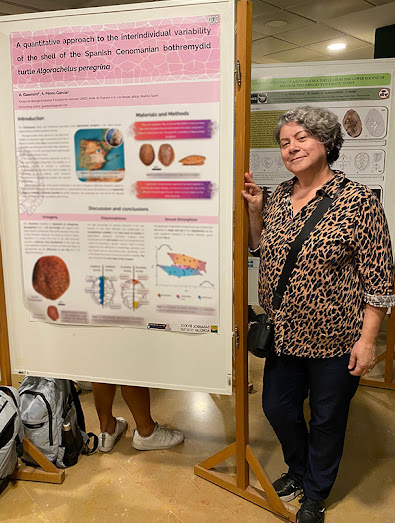Siguiendo con los trabajos sobre tortugas fósiles presentados por miembros del Grupo de Biología Evolutiva de la UNED durante las XXXVIII Jornadas de la Sociedad Española de Paleontología se encuentra el estudio de la variabilidad intraespecífica del botremídido Algorachelus peregrina. Concretamente, se ha analizado, tanto cualitativa como cuantitativamente, la variación morfológica resultado de la variación ontogenética, intraindividual y el dimorfismo sexual. El resumen de este trabajo se muestra a continuación:
The Cenomanian (lower Late Cretaceous) pleurodiran turtle Algorachelus peregrina is the oldest known representative of Bothremydidae in Europe. The type locality of this species (i.e., the uppermost middle or lowermost upper Cenomanian fossil site of Algora, in Central Spain), has provided numerous complete and well-preserved shells which allowed us to recognize it as the best-represented bothremydid for the entire European record. The availability of numerous specimens, as well as their generally good preservation, has enabled us, in previous studies, to provide a preliminary characterization of the shell of this taxon. In addition to describing its shell anatomy, some characters recognized as intraspecifically variable were reported qualitatively. In this context, the aim of the present contribution is not only to recognize additional characters subject to interindividual variability in the adult specimens (i.e., polymorphisms and sexual dimorphisms), or to expand the range of variability previously recorded for certain characters, but, especially, but carry out its first detailed characterization through a quantitative point of view. This allows us a comprehensive analysis of the shell morphology of A. peregrina, enabling to capture and analyse the complex form patterns as well as to identify the most subtle differences. Thus, a geometric morphometric approach has been applied to describe the shape changes, as well as to assess the role of the different morphological factors which have an impact on the adult disparity. The analyses revealed that most of the morphological variation can be explained by polymorphisms, which are recognized in several elements of the shell. In addition, two sexual dimorphs were recognized.
Más información:































No hay comentarios:
Publicar un comentario